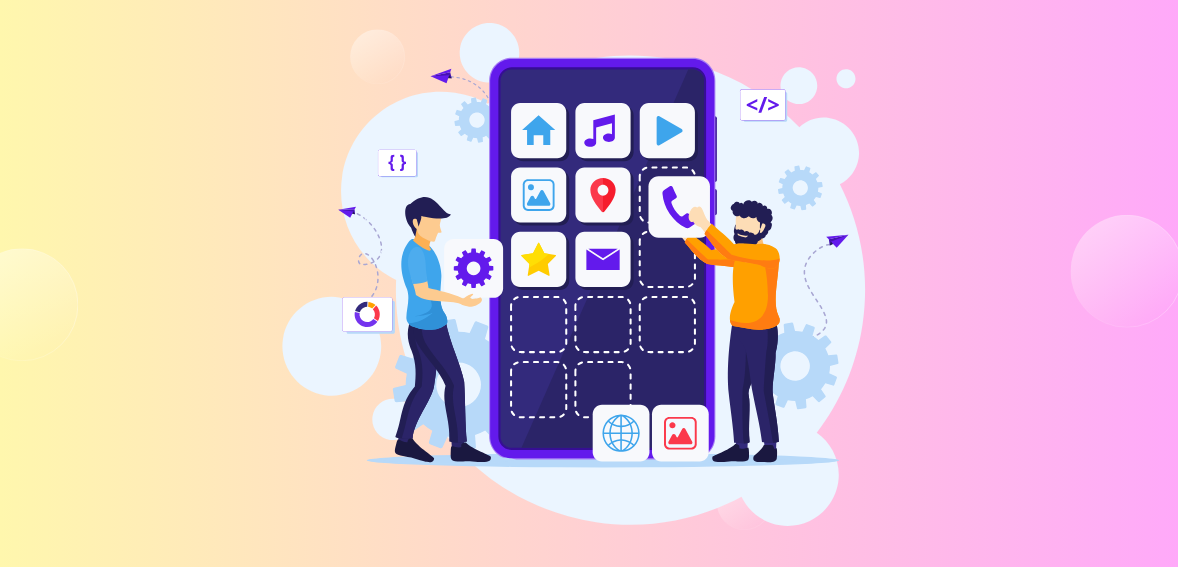Progressive Web Apps (PWAs) represent a pivotal evolution in web development, offering a compelling solution to amalgamate the functionalities of conventional websites and native mobile apps. In 2024, the significance of PWAs will be underscored by their ability to deliver seamless experiences across diverse devices and platforms. To stay abreast of the rapidly evolving landscape, it’s imperative to delve into the current trends and best practices governing PWAs.
With PWAs, users enjoy fast loading times, offline capabilities, and app-like experiences directly through their web browsers. As businesses increasingly leverage PWAs to enhance user engagement and conversion rates, understanding the latest developments in PWA technology becomes indispensable for staying competitive in the digital sphere.
Introduction to Progressive Web Apps (PWAs)
What are PWAs?
Progressive Web Apps (PWAs) harness cutting-edge web technologies to offer users an immersive application experience directly within their web browsers. By leveraging features like offline functionality, push notifications, and responsive design, PWAs provide a seamless and engaging expertise akin to native mobile applications.
Unlike traditional websites, PWAs offer fast loading times and the ability to work offline, enhancing accessibility and user retention. This innovative approach blurs the lines between web and app experiences, empowering businesses to deliver compelling digital solutions that cater to their audience’s evolving needs.
Importance of PWAs in 2024
In 2024, Progressive Web Apps (PWAs) are increasingly recognized for their capacity to offer swift, dependable, and captivating user experiences across a spectrum of devices and platforms. Their growing prominence stems from their capability to bridge the gap between web and app functionalities, providing users with seamless interactions regardless of their device.
PWAs boast fast loading times, offline accessibility, and a responsive design, ensuring consistent performance across different environments. This versatility enhances user satisfaction and enables businesses to reach a broader audience and drive engagement. As a result, PWAs are becoming indispensable tools for companies seeking to stay competitive and deliver superior digital experiences in the dynamic landscape of 2024.
Evolution of PWAs
Brief history of PWAs
In 2015, Google pioneered Progressive Web Apps (PWAs) to elevate web experiences, marking a significant milestone in web development. Over the years, PWAs have evolved substantially, continuously integrating innovative features and functionalities. Initially conceived to bridge the gap between websites and native apps, PWAs have evolved into robust solutions offering enhanced user engagement and performance.
Their evolution has been fueled by advancements in web technologies and a growing demand for seamless digital experiences. Today, PWAs boast offline capabilities, push notifications, and responsive design, empowering businesses to deliver immersive experiences across various devices and platforms. As PWAs continue to evolve, they remain at the forefront of modern web development, shaping the future of digital interaction.
Advancements in PWAs over the years
As web technologies advance, Progressive Web Apps (PWAs) have evolved into more robust solutions, providing enhanced features and functionality. These advancements enable PWAs to offer improved offline capabilities, allowing users to access content without an internet connection. Additionally, PWAs now support push notifications, allowing businesses to engage with users in real-time and enhance user retention.
Moreover, PWAs boast seamless performance, delivering fast loading times and smooth interactions across various devices and platforms. These enhancements have cemented PWAs as a powerful tool for businesses seeking to deliver compelling digital experiences to their audience, contributing to their widespread adoption and continued growth in the ever-changing landscape of web development.
Key Features of PWAs
Offline capabilities
Progressive Web Apps (PWAs) offer the unique capability to operate offline or with limited internet connectivity, ensuring uninterrupted access to content for users. This offline functionality distinguishes PWAs from traditional web applications, providing a seamless user experience even in challenging network conditions.
By caching essential resources, PWAs can continue to function without relying on a stable internet connection, making them ideal for users in areas with unreliable connectivity or those who frequently travel. This feature enhances accessibility and usability, allowing users to access critical information or perform tasks without constraints imposed by network availability. As a result, PWAs offer unparalleled convenience and reliability, catering to the diverse needs of modern users in an increasingly digital world.
Push notifications
Progressive Web Apps (PWAs) empower businesses to actively engage with users through push notifications, a feature traditionally associated with native mobile applications. By sending timely and relevant updates, promotions, or reminders directly to users’ devices, PWAs foster increased engagement and retention. These push notifications are a powerful tool for businesses to re-engage users, encourage return visits, and drive conversions.
By leveraging push notifications, companies can stay top-of-mind for users, delivering personalized and targeted messages that enhance the overall user experience. This proactive approach to user engagement strengthens the relationship between businesses and their audience and contributes to improved customer loyalty and retention rates, ultimately driving business growth and success.
Fast loading times
Progressive Web Apps (PWAs) are renowned for their exceptional loading speed, guaranteeing a seamless and responsive user experience. This swift loading time results from streamlined code, optimized assets, and advanced caching mechanisms employed by PWAs. By prioritizing performance, PWAs ensure users can access content quickly and efficiently, minimizing wait times and enhancing overall satisfaction.
This responsiveness contributes to a positive user perception and encourages continued engagement with the app. Whether accessing the PWA on a desktop or mobile device, users can expect consistent and swift performance, reaffirming the appeal and effectiveness of PWAs as a modern web development solution.
App-like experience
Progressive Web Apps (PWAs) enhance usability and accessibility by incorporating fullscreen mode and home screen installation features. With fullscreen mode, PWAs utilize the entire screen space, offering a distraction-free browsing experience similar to native mobile applications. Additionally, PWAs can be installed directly onto the user’s device’s home screen, enabling quick and easy access without the need to navigate through a browser.
This app-like interface improves user engagement and encourages frequent usage, as PWAs seamlessly integrate into the user’s device environment. By leveraging these features, PWAs blur the lines between web and native apps, providing users with a familiar and intuitive experience across various devices and platforms.
Trends in PWAs for 2024
Increased adoption across industries
In 2024, there’s a noticeable uptick in adopting Progressive Web Apps (PWAs) across diverse industries such as e-commerce, media, and healthcare. This surge is propelled by businesses acknowledging the importance of providing seamless experiences to their users. PWAs offer a compelling solution by combining the best features of web and native applications, delivering fast loading times, offline accessibility, and engaging user interfaces. In e-commerce, PWAs enable smooth browsing and purchasing experiences, while in media, they facilitate instant content access and personalized recommendations.
Similarly, PWAs streamline patient communication and access to medical information in healthcare. As a result, businesses across various sectors are increasingly leveraging PWAs to enhance user satisfaction and stay competitive in the digital landscape of 2024.
Enhanced user experiences
Progressive Web Apps (PWAs) prioritize enhancing user experiences by incorporating personalized content, intuitive navigation, and immersive interactions. PWAs create a more engaging and relevant user experience by tailoring content to individual preferences and behaviors. Intuitive navigation ensures users can easily find what they’re looking for, improving overall usability and satisfaction.
Additionally, PWAs integrate immersive interactions, such as gestures and animations, to make the user experience more dynamic and enjoyable. These efforts underscore PWAs’ commitment to delivering user-centric experiences that meet and exceed user expectations, driving increased engagement and loyalty in the competitive digital landscape.
Integration with emerging technologies
Progressive Web Apps (PWAs) are embracing emerging technologies like artificial intelligence (AI) and augmented reality (AR) to create innovative and immersive user experiences. By leveraging AI, PWAs can analyze user behavior and preferences to personalize content and recommendations, enhancing engagement and satisfaction. Additionally, AR integration enables PWAs to overlay digital information onto the physical world, offering interactive and immersive experiences to users.
Whether it’s virtual try-on experiences for e-commerce or interactive storytelling for media platforms, PWAs are harnessing the power of AI and AR to push the boundaries of web development and provide users with captivating and memorable interactions. This convergence of technology enhances the appeal and utility of PWAs, positioning them as cutting-edge solutions in the digital landscape.
Best Practices for Developing PWAs
Responsive design
Developers must prioritize responsive design to ensure that Progressive Web Apps (PWAs) deliver a seamless experience across devices of varying sizes. Responsive design enables PWAs to adapt and optimize their layout, content, and functionality according to the screen size and the device’s orientation. By implementing responsive design principles, developers can guarantee that users receive a consistent and visually appealing experience whether they’re accessing the PWA on a desktop, tablet, or smartphone.
This approach enhances usability and accessibility, allowing users to navigate and interact with the PWA effortlessly, regardless of their preferred device. Ultimately, prioritizing responsive design contributes to a positive user experience and maximizes the PWA’s reach and effectiveness across diverse devices and platforms.
Optimized performance
Optimizing performance is paramount for Progressive Web Apps (PWAs) to ensure rapid loading times and seamless interactions, ultimately enhancing user satisfaction and engagement. By minimizing loading times and maximizing responsiveness, PWAs provide users with a fluid and enjoyable browsing experience, encouraging prolonged engagement and repeat visits. Performance optimization encompasses various strategies, including code optimization, image compression, and minimizing server requests to reduce latency and improve overall responsiveness.
Additionally, caching frequently accessed resources and leveraging browser caching mechanisms further enhance performance by enabling quicker access to content. Ultimately, prioritizing performance optimization is essential for PWAs to meet user expectations, retain users, and achieve their business objectives in the competitive digital landscape.
Secure connections
Implementing secure connections through HTTPS is vital for safeguarding the confidentiality and integrity of user data, thereby fostering trust and credibility. By encrypting data transmitted between the user’s device and the PWA’s server, HTTPS prevents unauthorized access and tampering, mitigating the risk of data breaches and cyberattacks.
This commitment to data security protects sensitive information such as passwords and payment details and instills confidence in users regarding the PWA’s reliability and commitment to privacy. As a result, users are more likely to engage with the PWA, share personal information, and conduct transactions, ultimately bolstering the reputation and success of the business behind the PWA.
Progressive enhancement
Adopting a progressive enhancement approach empowers developers to prioritize essential functionalities, ensuring a consistent user experience across all devices, browsers, and network conditions. By focusing on core features that are universally accessible, PWAs become more inclusive and resilient to variations in user environments. As users access the PWA from different devices with varying capabilities, progressive enhancement enables the gradual addition of advanced features and optimizations tailored to each user’s context.
This iterative approach maximizes accessibility and usability while accommodating diverse user needs and preferences. By embracing progressive enhancement, developers can create PWAs that deliver a seamless experience to all users, regardless of their device or browsing conditions, fostering engagement and satisfaction.
Case Studies: Successful Implementation of PWAs
Examples of companies leveraging PWAs effectively
Companies like Starbucks, Twitter, and Pinterest have effectively implemented Progressive Web Apps (PWAs), witnessing notable enhancements in user engagement and conversion rates. By leveraging PWAs, these companies have extended their reach to a broader audience while delivering seamless, immersive user experiences. PWAs offer fast loading times, offline accessibility, and app-like interactions, encouraging users to interact more frequently and stay engaged with the platform.
Additionally, the lightweight nature of PWAs enables faster performance and smoother navigation, contributing to increased user satisfaction and retention. As a result, these companies have seen tangible improvements in key metrics such as user engagement, time spent on site, and conversion rates, underscoring the efficacy of PWAs in driving business success in the digital era.
Benefits experienced by these companies
Transitioning to Progressive Web Apps (PWAs) has yielded several company benefits, including increased user retention, higher conversion rates, and improved performance metrics. By adopting PWAs, these companies have created more engaging and user-friendly experiences, prompting users to return to the platform and spend more time interacting with content. The fast loading times and offline capabilities of PWAs contribute to a seamless user experience, enhancing satisfaction and loyalty.
Moreover, the improved performance of PWAs leads to higher conversion rates, as users are more likely to complete desired actions, such as making purchases or signing up for services. Overall, the transition to PWAs has proven to be a strategic investment, driving positive outcomes and reinforcing the value of user-centric design in digital business strategies.
Challenges and Solutions in PWA Development
Compatibility issues
Ensuring compatibility across browsers and devices poses a challenge in Progressive Web App (PWA) development. Leveraging progressive enhancement techniques can mitigate these compatibility issues effectively. PWAs ensure a consistent user experience regardless of the user’s device or browser choice by prioritizing core functionalities that work universally across all platforms. Progressive enhancement allows developers to layer additional features and optimizations based on the capabilities of the user’s device, ensuring that advanced functionalities are only enabled in incompatible environments.
This approach enhances accessibility and future-proofs the PWA, allowing it to adapt seamlessly to new technologies and browser updates. Ultimately, by embracing progressive enhancement, developers can create robust and inclusive PWAs that cater to diverse users while mitigating compatibility challenges.
Limited device access
Limited access to device features, such as hardware sensors, presents another challenge in Progressive Web App (PWA) development. Developers can overcome this limitation by utilizing web APIs and polyfills. Web APIs provide standardized interfaces for accessing device functionalities, allowing developers to integrate features like geolocation, camera, and accelerometer into PWAs. Additionally, polyfills serve as fallback solutions for unsupported features, enabling PWAs to maintain functionality across a broader range of devices and browsers.
By leveraging these tools, developers can enhance the capabilities of PWAs, providing users with more prosperous and more immersive experiences while ensuring compatibility across diverse devices and platforms. This approach enables PWAs to harness the full potential of web technologies while addressing the challenges posed by device limitations.
Strategies to overcome challenges
To overcome challenges in Progressive Web App (PWA) development, developers should prioritize staying updated with the latest web standards, conducting thorough testing, and implementing progressive enhancement strategies. By keeping abreast of evolving web technologies and standards, developers ensure that their PWAs adhere to best practices and take advantage of the latest features and optimizations. Thorough testing across various devices and browsers helps identify and address compatibility issues early in development.
Additionally, implementing progressive enhancement strategies allows developers to prioritize core functionalities while progressively enhancing the user experience based on device capabilities, ensuring a consistent and inclusive experience for all users. By adopting these practices, developers can overcome challenges and create robust, high-performing PWAs that deliver exceptional user experiences.
Future of PWAs
Predictions for the future of PWAs
Looking ahead, Progressive Web Apps (PWAs) are on track to become even more widespread, fueled by ongoing advancements in web technologies and growing adoption across industries. As businesses recognize the benefits of PWAs in delivering fast, reliable, and engaging user experiences, the demand for these versatile applications is expected to rise.
With innovations such as enhanced offline capabilities, improved performance, and seamless integration with emerging technologies, PWAs will continue to evolve and adapt to meet the changing needs of users and businesses alike. This trajectory positions PWAs as a cornerstone of modern web development, offering a scalable and cost-effective solution for delivering compelling digital experiences across devices and platforms.
Potential advancements and innovations
Progressive Web Apps (PWAs) are poised for innovation, particularly in offline capabilities, push notifications, and integration with emerging technologies. Advancements in offline capabilities will enable PWAs to offer more robust offline experiences, allowing users to access content and perform tasks without an internet connection. Additionally, improvements in push notifications will allow businesses to deliver more personalized and timely updates to users, enhancing engagement and retention.
Moreover, integration with emerging technologies such as artificial intelligence and augmented reality will further elevate the capabilities of PWAs, enabling immersive and interactive experiences that blur the lines between web and native applications. These innovations will solidify PWAs’ position as a leading solution for delivering seamless and engaging experiences across various devices and platforms.
Conclusion
In conclusion, Progressive Web Apps (PWAs) mark a profound evolution in web development, providing users with fast, reliable, and captivating experiences across diverse devices and platforms. As we progress through 2024, businesses must adopt the latest trends and best practices in PWA development to maintain a competitive edge in the digital realm. PWAs offer unparalleled advantages, including offline capabilities, push notifications, and seamless performance, enhancing user satisfaction and engagement.
By embracing these advancements and prioritizing user-centric design principles, businesses can forge stronger connections with their audience and drive sustainable growth in an increasingly digital landscape. As such, PWAs are a cornerstone of modern web development, reshaping how businesses interact with their users and setting new standards for online experiences.
FAQs
- Are PWAs compatible with all devices and browsers?
- PWAs are designed to be compatible with a wide range of devices and browsers. However, thorough testing is recommended to ensure optimal performance across different platforms.
- Can PWAs work offline?
- Yes, PWAs can function offline or with a poor internet connection, allowing users to access content even when they’re offline.
- How do PWAs benefit businesses?
- PWAs offer several benefits to businesses, including increased user engagement, higher conversion rates, and improved performance metrics.
- Are PWAs secure?
- Yes, PWAs prioritize security by implementing secure connections through HTTPS, ensuring the safety and privacy of user data.
- What are some examples of successful PWAs?
- Companies like Starbucks, Twitter, and Pinterest have successfully implemented PWAs, experiencing significant improvements in user engagement and conversion rates.





